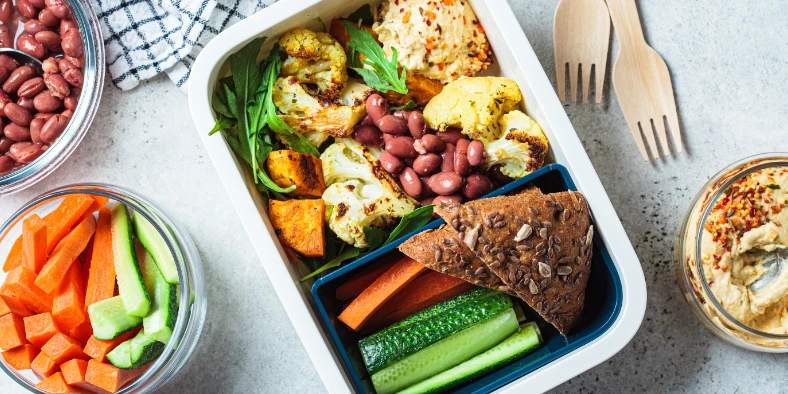Part one of our look into the existing and upcoming food trends of 2024 saw us look at the use of real food, whole foods, and cooking with nostalgia, alongside the treat occasion. Now, we’re moving forward with four additional trends that are shaping the future. These include the ongoing focus on health-conscious functional food and personalised nutrition, the advent of new technology, and a shift towards sustainability in food production. This enables us to cater to customer needs, whether it’s allergen-free or nutrient and protein-rich foods. The debate around vegan alternatives continues, and 5D printing is producing remarkable meat substitutes.

Trend: Functional Food
Functionality is front-and-centre for health-savvy consumers. And as their knowledge continues to evolve so do their expectations of the functional sphere. This section looks at gut health, protein perks, stress-busting and on-the-go health solutions – are there some techniques you could incorporate onto your menu?
- Strength in protein: Protein-enriched food has long had a grip on consumers. But now, the question is ‘Where has the protein come from?’ Whether it’s in the form of whey or plant-based protein, consumers want to ensure the protein they’re consuming isn’t super processed and is as natural and in some cases, sustainable as possible. This feeds into part 1 of our trends article, where we discussed the importance of using ‘real food’ instead of processed plant-based alternatives.
- Gut 360: Gut health and our digestive wellness remains in the spotlight. Not only are consumers buying into more over-the-counter prebiotic and probiotic medicines, they’re also on the lookout for gut-enriching foods when looking at a menu; the ‘Superfood Salad’ is still popular, containing everything from blueberries and cashew nut dressing sweetened with Manuka honey.
- Stress-free: Stress-free comes in the form of everything from herbal remedies to CBD-infused drinks and consumables. In your establishment, you could offer herbal teas and a good selection of decaffeinated tea (like Rooibos) and coffee to cater for this trend.
- Healthy on-the-go: Consumers expect their food and drinks to keep up with the pace of their busy lives, yet they still need to hit their nutritional needs. This feeds into our healthy, on-the-go, foods, whether that’s a probiotic-filled overnight oats breakfast they can swipe off the shelf or ready-to-drink (RTD) coffee available in the fridge.
What could this mean for you?
Think about how you can create protein and nutrient-dense meals, and find ways to turn these into on-the-go formats, too. This could be overnight oats, packed with protein and probiotic yoghurt, nuts and berries.
If you have a drinks fridge – and the right customer base – it could be worth stocking one or two lines of CBD-infused drinks, probiotic yoghurt drinks or kombucha etc.

Trend: Individual Health
One size doesn’t fit all. Using science and technological advances, scientists are finding personalised solutions to match our individual health needs, whether that’s weight management, nutrition or lifestyle.
- Biohacking – Enhancing and extending our lives by leveraging genetics, biology, neuroscience and nutrition. This is everything from breathwork practices to finding the ‘Blue Zones’, where people apparently live longer.
- Female support – Insufficient research has been conducted on women, particularly in the areas of pregnancy, postpartum, and menopause. However, recent increases in female health studies have led to the development of a new range of products designed to support women through their unique experiences.
- Kid-novation – Nutrition is crucial during a child’s development. Parents are increasingly examining food labels and making efforts to prepare home-cooked meals for their children. A variety of supplements and personalised nutrition foods for kids are now available on the market.
- Allergen friends – Food allergies are more prevalent than before. There’s a growing demand for products which don’t contain any of the top nine major allergens, and as such, innovation is high in this area – but it isn’t cheap.
- Whatever the budget – Consumer demand drives innovation, but most of the time ‘health comes at a price’. Ambient favourites, which are much cheaper, yet still packed with nutrients are becoming more widely available and ‘trendy’ – thanks to social media. This is everything from frozen fruit and veg to pulses and protein-enhanced foods.
- Weight management – Glucose monitoring is increasing people’s awareness of their ‘metabolic disruptors’ more than ever. However, it’s not only about what you eat. The way food is packaged can also potentially lead to metabolic disruption.
- Dry or damp – 29% of regular drinkers are consuming less alcohol than before the pandemic, according to YouGov, and going dry is a huge trend on social media. With this in mind, lower ABV producers and alcohol-free alternatives should be on your menu – especially with the amount of innovation there is behind these products now.
What could this mean for you?
The famous ‘Blue Zone’ usually follows a Mediterranean diet: could you incorporate more of these ingredients into your menu?
All restaurants consider allergens when designing a menu and do their best to cater for those with an allergy, dining in their venue – but can you develop more allergen-free dishes?
Finally, more people are now on weight management drugs: could you offer a variety of portion sizes for certain dishes?

Trend: Food Frontiers
The alternative protein industry is fast-moving, with products that look, taste, and feel surprisingly like meat. Plus, we’re discovering plant proteins could be the way of the future…
- Pillars of protein: Cultivated meat is now available commercially in the USA and it’s only a matter of time before it’s mainstream in the UK, using cultivated, fermentation and molecular farming techniques.
EU’s first mycelium-based chicken breast, made via biomass fermentation.
- Like the real thing: It’s not just pieces of chicken, innovation and technologies have allowed companies to create whole pieces of meat, like ribs and beef joints, and even poached eggs! A key focus is getting these products to have the same texture and flavour as possible.
Fibre-spinning technology to mimic meat muscle tissues with plant proteins.
- The best of both worlds: Some companies are using the above technology to create food which is both plant and animal-based. So, while it’s not strictly vegan, it’s a way of creating a more ‘meaty’ flavour in plant-based products.
Combining plant-based meat with cultures beef cells for ‘flavour impact’. - Sugar alternatives: Scientists are harnessing precision fermentation technology to develop sweet proteins (eg. Oobli – derived from West African Oobli fruit but this one has far less sugar). Others are leveraging tech platforms to identify and isolate previously untapped sweet proteins. There’s also the ability to create food sources from ‘thin air’, or captured carbon dioxide.
The world’s first gelato made from captured carbon debuted in Singapore Solar Foods.
- Molecular farming: Engineering plants to grow high-value compounds. Essentially, engineers introduce animal DNA directly into seeds, transforming the crops into protein factories. Once the seeds are plated, traditional farming can be used to grow the crops to harvest, at which point the proteins are extracted.
This process has been used by pharma for years but now the focus is on how it can be used to make food.
Using molecular farming technology to grow port protein in soybeans.
- Next-gen printing: 5D and 6D printing technologies offer exciting potential for the future of food and packaging. This level of printing allows for the creation of more curved and complex objects.
- Temperature matters: Temperature impacts molecular structure and therefore also the quality and taste of food and drink, in both production and consumption. Playing with temperatures can enhance the experience – think of how we serve wine at a specific temperature. Well, now some people are even ageing wine at sea!
What could this mean for you?
If you’re a predominantly vegan establishment, this is something you’re going to want to keep a close eye on. At the moment, these types of technologies are expensive, as is the ‘meat’ they’re producing – but it won’t be long before it’s mainstream.

Trend: Harnessing AI
Love it or hate it, AI is modern-day reality. Those who use it properly can leverage it to get ahead – scientists are already using it to speed up world-changing discoveries, while food producers are using it to cut costs and improve efficiency and agricultural sustainability.
- AI + human intelligence: The key to growth and success is efficiency. In foodservice, this could see robots taking over tasks like chopping to increase formality and speed. It can also be useful for coming up with new recipes.
- Speeding up science: AI can swiftly analyse extensive datasets from nutritional profiles to consumer preferences, which allows us to identify patterns in the food industry faster. Some food startups are using it to help meet industry standards, by automating regulatory compliance checks.
- Cost and efficiency: AI can analyse sales data, seasonal dining patterns, stocking issues, and more. It can also be used in robots to help with labour costs for repetitive tasks like packaging and sorting.
- Green machines: AI can help replace agricultural practices, like mono-cropping, blanket application of chemicals, and intensive land use, with more regenerative agricultural practices. It’s also been used to help detect spoilage and contamination in food.
- Consumer experience: AI can be used for personalisation, whether that’s creating the perfect recipe for someone or recommending a wine pairing based on data.
- Creativity: We’re not all creative geniuses and AI can help inject a little more creativity when it lacks. It can suggest food presentation ideas, enhance and generate food photography, create visually appealing social media, and so much more.
What could this mean for you?
Could you work more efficiently with AI? Do you need help to bring creativity to your menu? Could you save time on marketing costs by using AI to help post? Maybe it’s time to look at AI…
Each trend not only points towards a more health-conscious and technologically integrated future for the food industry but also highlights the importance of sustainability and personalisation in catering to diverse consumer needs.
























